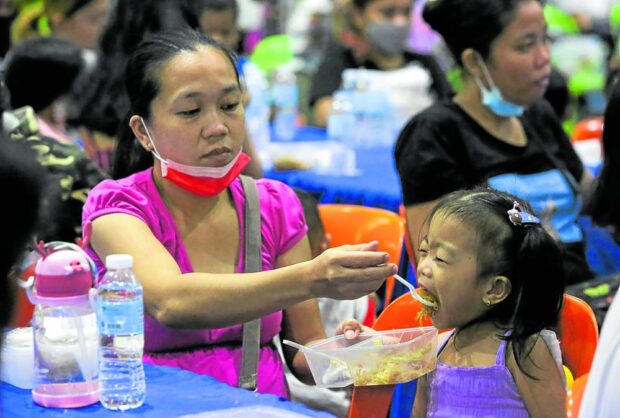Businessmen join drive vs child malnutrition

NUTRITIOUS LUNCH | A child is fed snacks before getting a complete meal of rice, meat and vegetables during a food program. (File photo by LYN RILLON / Philippine Daily Inquirer)
MANILA, Philippines — The Management Association of the Philippines (MAP) on Monday said it has convened a multisectoral meeting on the rising case of child malnutrition in the country, paving the way for a unified collaboration among the government, nongovernmental organizations, and business groups toward addressing the problem.
The business management group said that 41 organizations have agreed to become part of the Campaign Against Malnutrition and Child Stunting movement, which was designed to address these child nutrition issues in the country.
“Preventing child stunting matters because malnutrition makes our children vulnerable to risks of infection and if unchecked, will unduly tax our health system’s resources,” Benedicta Du-Baladad, president of MAP, said in a statement.
“Child stunting affects cognitive development, and this can later on have an impact on their capacity to be productive, resulting in lower economic output and poorer quality of life. And that becomes a major impediment to competitiveness and national development,” she said.
Former Sen. Jose David Lina Jr., who has also convened the multisectoral alliance Children’s 1st One Thousand Days Coalition, also spoke of the consequences of malnutrition on a child’s physical stature.
Article continues after this advertisement“There is also the effect on the physical body; the height is affected,” he said, highlighting the limitation this will pose for people who want to work in certain industries.
Article continues after this advertisement95 Pinoy kids die daily
“We are stressing that the first 1,000 days of life, that is the period when the human brain gets to be developed. And if the child is malnourished, then the damage to the brain is already done and almost irreversible,” he added.
According to the United Nations International Children’s Emergency Fund Philippines, 95 Filipino children die daily from malnutrition, while 27 out of every 1,000 children do not get past their fifth birthday.
A third of Filipino children are also stunted or too short for their age, according to the same UN agency.
Meanwhile, the World Bank said that the Philippines ranked fifth among countries in the East Asia and Pacific region with the highest prevalence of stunting and is among the 10 countries in the world with the highest number of stunted children.
The international banking organization has also warned of the persistence of very high levels of child undernutrition in the Philippines despite decades of economic growth and sector-wide poverty reduction programs.